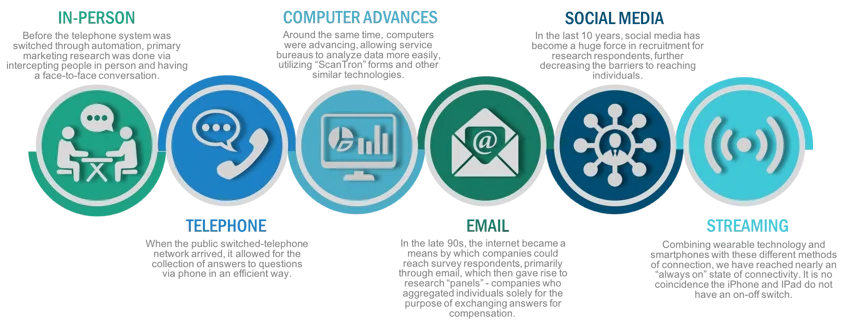Since its start nearly 100 years ago, marketing research has gone through several big changes, few as significant as that for which we are poised currently. Looking back nearly 50 years, the implementation of automated switching equipment at central offices for the telephone, the use of computer technology for data management and analysis, and the rise of the Internet and the Web all had massive impact on the cost and time required to conduct primary research. Today, we are watching the next macro change in primary research, yet many will not be able to take advantage of the opportunities it affords. We will get to that in a minute.
For those of you who are not familiar, primary marketing research is research where the primary source of information comes directly from those individuals who are engaged for answers, as opposed to secondary marketing research, where information is sourced from resources already existing, such as industry reports, etc. Primary research (also called “custom research” by some), is also known for being costly and time-intensive, and has been becoming less and less so over time.
Reaching Respondents, Yesterday, Today and Tomorrow

The rise in wearable technology combined with smartphones have created a near “always-on” state of connectivity. It is no coincidence the iPhone and iPad have no on-off switch.
In conjunction with the “always on” status, integrated interfaces that simplify the process of fitting questions into everyday life are also increasingly available. This makes it easier for the research participant to offer answers to questions in an impromptu manner.
“Always on”, coupled with integrated interfaces, is the ultimate reduction in friction for marketing research. Welcome to the age of micro-research interactions.
Just as Apple Pay and NFC Point of Sale systems have enabled the wide acceptance of easy micropayments and Spotify and Pandora have allowed for the streaming of music, these connectivity advances have allowed for the streaming of marketing insights, from consumer to business or business to business.
Alas, most businesses will not benefit from these new capabilities. Why is that? Because they are geared up to consume research and plan for the consumption of research based on the old way of doing things.
Buying Primary Marketing Research is like Buying Records
Marketing research has required longer interactions between the researcher and the respondent to achieve economies of scale, especially the aggregation of a critical mass of questions so that the questionnaire could be long enough to justify the expense. This is how most companies plan to use marketing research; questions are gathered up in groups, analyzed in groups, and reported upon in groups.
This is not unlike the evolution of music distribution. Before the Internet came along to enable music efficiency, artists and labels had to gather together enough songs to fill up a record (and eventually a tape or CD) so distributing it would be cost effective. Today however, music is largely streamed, and now, marketing research insights can be streamed as well.
In this upcoming blog series, we will be digging deeper into this new paradigm for gathering primary marketing research insights and enable you to prepare your team, department, or research stakeholders to plan for using streamed research, resulting in fresher insights, lightning fast turnaround times by primary research standards, and all for a lower investment.



